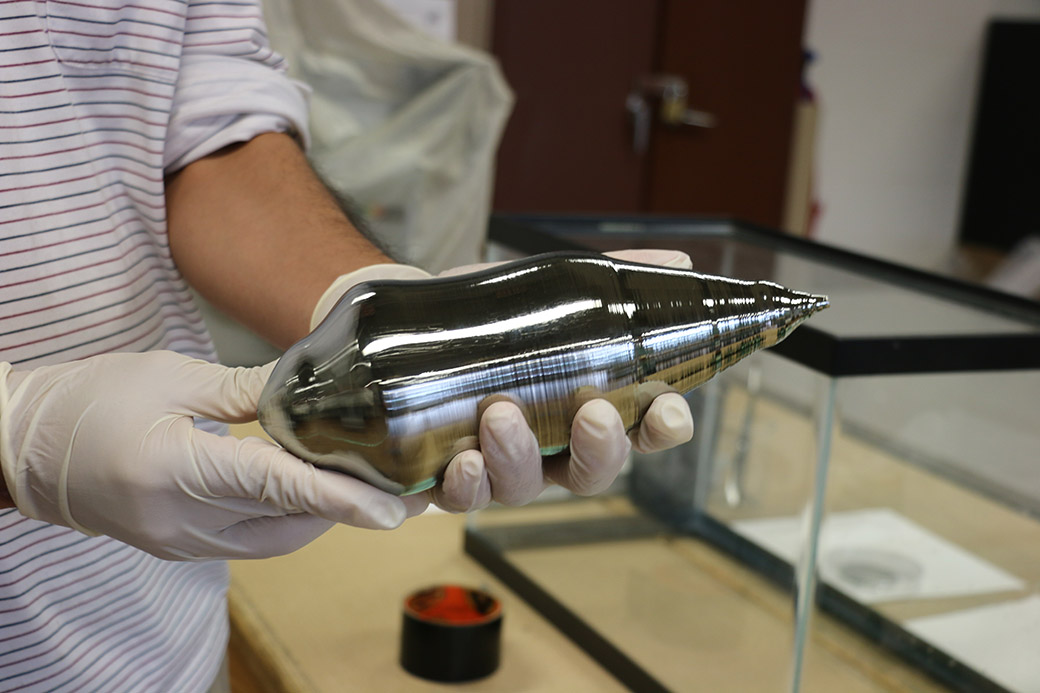
USD physics team uses germanium to detect dark matter
Throughout the universe a substance exists that can’t be detected with a telescope, and the only evidence of it is the effect it has on visible objects in space.
A team of USD research faculty, undergraduate students and graduate students are growing germanium crystals to make detectors that will help detect and study dark matter – one of only four places in the world to do so.
Professor Dongming Mei, who is the head of the project, has been working on dark matter research for six years.
“Dark matter is the mystery particles in the universe,” Mei said. “We know it has mass, so we need something to detect that mass. Germanium is used as a target to detect dark matter. Incoming energy hits the germanium and detects the charges and such of the dark matter and allows us to get data about dark matter.”
More is known about what dark matter isn’t than what it is.
It’s been proven dark matter is not in the form of planets or stars, dark clouds or antimatter. However, researchers at USD are hoping to discover more information about what dark matter is, including its mass, what it’s made out of and what its purpose is.
Germanium was chosen as a detector because it can be refined into a pure form, Dongming Mei said.
Due to lack of space, students participating in the project have started growing the crystals, but not making detectors out of them. Instead, they’re growing and gathering information from detectors made elsewhere.
“We aren’t at the point yet where we can make detectors yet, but we have the space and will be able to in the next few years,” Physics Associate Dean Christina Keller said. “You need high level germanium crystals made into detectors to help detect dark matter. That’s what we are doing and are going to do here at USD.”
The crystals are grown two to three times a week. Graduate student Hoa Mei has been working with these crystals for four years.
“It is the major stage before the crystallization process. After the crystal growth is purified, we fabricate the crystal into a germanium detector,” he said.
Dongming Mei said the project’s participants will be getting a lot out of the research experience.
“The students will be learning many different things,” he said. “ They will learn the connection between solid-state physics and particle physics, how to grow a high-purity germanium crystal, how to convert a crystal into a detector, how a detector would be used to detect dark matter particle and much more.”
The USD research team has been growing crystals for the past five years and is hopeful for the project’s future potential.
“We want to detect dark matter,” Dongming Mei said. “We want to understand how the universe functions and how it evolved. We want to explore a lot of questions on what is the origin of matter. But these are very big questions. Out of all these big questions dark matter is the biggest one unsolved. That’s what makes me so excited about it.”
Hoa Mei said he sees this experience as a rare opportunity.
“We are the only universities in the world that is doing this, so it is pretty cool,” he said. “We are doing some very particular and very special work here.”
(Photo: Graduate student Hao Mei hold a germanium crystal that was grown in a physics lab at USD. Mei said the growing of the crystal is more like art than science. Tatum Dean / The Volante)
One thought on “USD physics team uses germanium to detect dark matter”
Comments are closed.



“Mei said the growing of the crystal is more like art than science.” Sounds like some interesting work. With regard to the statement above, I used to believe that as well. When we don’t really understand how to do something, we call it “art.” Here at 5N Plus Semiconductors in southern Utah, we routinely grow dislocation-free germanium single crystals (Czochralski method) up to 6″ in diameter and most of a meter long (limited only by weight), and our 4″ crystals are uniform and routinely 1.5 to 2 meters long. All of the material is electrically uniform (whether doped or undoped). Admittedly, it took years to figure out how to do it, but it went from art to science (in this case, the science of eliminating defect propagation from the seed, and controlling the growth interface with considerable precision). We are the only U.S. domestic National Security Space qualified Ge wafer vendor. Feel free to contact us if you need state-of-the-art single-crystal epi-ready Ge wafers or ingots in (100) or (111) orientation, or any off-axis configuration, up to 15 degrees off-axis. Contact W. Brock Alexander, Ph.D., at brock.alexander@5nplus.com, (435) 628-5900 x101.